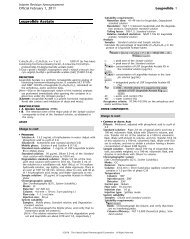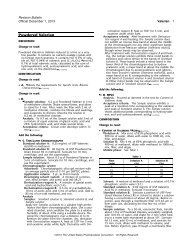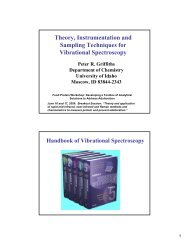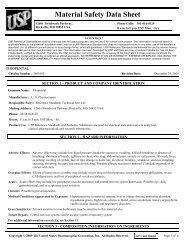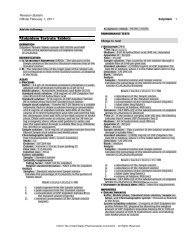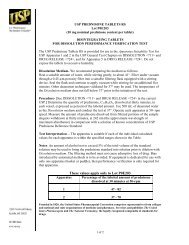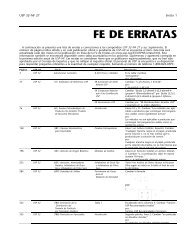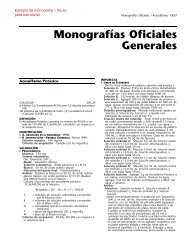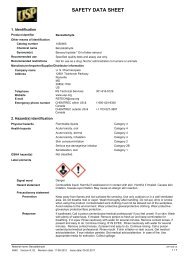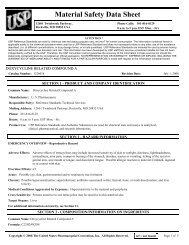You also want an ePaper? Increase the reach of your titles
YUMPU automatically turns print PDFs into web optimized ePapers that Google loves.
USP Bioassay Workshop<br />
August 12-13, 2009<br />
USP Headquarters<br />
Quality Standards for Medicines, Supplements, and Food Ingredients throughout the World
Regulatory perspective on<br />
vaccine potency assays<br />
USP’s 2 nd Bioassay Workshop<br />
August 13, 2009<br />
Phil Krause, MD<br />
FDA/CBER
Potency<br />
Specific ability or capacity of the product,<br />
as indicated by appropriate laboratory<br />
tests or by adequately controlled clinical<br />
data obtained through the administration<br />
of the product in the manner intended, to<br />
effect a given result. -- [21 CFR §600.3<br />
(s)]<br />
2
Tests for Potency<br />
Tests for potency shall consist of either in<br />
vitro or in vivo tests, or both, which have<br />
been specifically designed for each<br />
product so as to indicate its potency in a<br />
manner adequate to satisfy the<br />
interpretation of potency given by the<br />
definition in § 600.3 (s) of this chapter. --<br />
[21 CFR § 610.10]<br />
3
Why do we do a potency assay?<br />
• In development, to:<br />
– Assure that safe potencies are not exceeded in clinical trials<br />
– Obtain information that will support licensure‐including<br />
correlation of potency with clinical response<br />
• After licensure, to assure that lots behave similarly to<br />
those tested in the clinical trials that supported licensure<br />
– The potency should not be below the lowest potency believed to<br />
be efficacious<br />
– The potency should not exceed the highest potency believed to<br />
be safe<br />
• The potency assay thus provides a “bridge” between<br />
licensed material and the clinical trials
What does a potency assay tell us?<br />
• The assay estimates the mean potency value for a lot<br />
• There are two sources of variability in the measured<br />
potency of an individual vial from the same vaccine<br />
lot– manufacturing variability and assay uncertainty<br />
• Thus, we can never know the actual potency in an<br />
individual vial that is given to a vaccine recipient<br />
• We can know the characteristics of the lot of vaccine<br />
from which that vial came (we routinely estimate the<br />
mean potency)
Necessary attributes for<br />
potency assays<br />
• Predictive of clinical benefit<br />
• Possess characteristics that are amenable to<br />
validation<br />
• Precision sufficient to meet goal of potency<br />
assays, i.e., provide assurance that vaccine<br />
is safe and effective throughout the dating<br />
period<br />
– Includes for use in stability studies<br />
– Includes for use in the “bridge” between marketed<br />
and clinical trial materials<br />
• Stability indicating<br />
6
Choosing “the right thing”<br />
Every worker in biology<br />
must know the temptation<br />
to adopt a method<br />
because it measures<br />
something with<br />
reasonable precision,<br />
without waiting for<br />
conclusive evidence that<br />
what it measures is the<br />
right thing<br />
- Sir Henry Dale<br />
Nobel Laureate in Medicine, 1936<br />
7
Not everything that<br />
counts can be<br />
counted, and not<br />
everything that can<br />
be counted counts.<br />
‐Albert Einstein
Building the Bridge<br />
Clinical Lots Assay Results<br />
Potency Assay Bridge<br />
During clinical development, it is necessary to<br />
establish a quantitative link between product efficacy<br />
and laboratory measured parameters? What are the<br />
relevant parameters to use? How do we choose the<br />
“right thing.”<br />
9
Building the Bridge<br />
Clinical Lots Marketed Lots<br />
Potency Assay<br />
Bridge<br />
An assay, or set of assays, is used to measure the<br />
comparability of a given lot of product to those lots of<br />
product that were used in the clinical trials to establish<br />
efficacy. Were the relevant parameters established?<br />
10
Building the Bridge<br />
• Establishing a bridge between clinical outcomes<br />
and laboratory test parameters is enabled by<br />
– Knowledge of disease pathogenesis and mechanisms of<br />
mediation<br />
– Existence of surrogate markers<br />
– Characterization of products (antigens and antibodies<br />
for vaccines)<br />
– Existence of appropriate animal models<br />
– Data from clinical trials<br />
11
Relationship between potency and<br />
surrogate markers<br />
• Potency refers to the ability to effect a clinical<br />
outcome<br />
• Surrogate markers, in clinical subjects, predict<br />
actual clinical outcomes, and imply an<br />
understanding of the mechanism of action<br />
• Often, the best potency assays measure attributes<br />
of the product that are likely to induce a response<br />
measured by a surrogate marker<br />
12
Surrogate Markers<br />
“surrogate endpoint . . . is reasonably likely, based<br />
on epidemiologic, therapeutic, pathophysiologic, or<br />
other evidence, to predict clinical benefit or on the<br />
basis of an effect on a clinical endpoint other than<br />
survival or irreversible morbidity.”<br />
[21 CFR 314.510 (Subpart H) Accelerated approval]<br />
13
Building the Bridge<br />
• In the absence of an existing laboratory<br />
surrogate of protection, establishing the<br />
ability to accurately assess potency, i.e.,<br />
develop the potency assay, will rest on<br />
clinical results with drug preparations of<br />
varying measured quality.<br />
14
Development of a potency test:<br />
whole-cell pertussis vaccine<br />
1940’s: Potency test<br />
for whole-cell<br />
pertussis vaccine<br />
Kendrick & Pittman<br />
Mouse protection<br />
from a lethal<br />
intracerebral<br />
infection<br />
15
Development of a potency test:<br />
whole-cell pertussis vaccine<br />
1950’s: UK MRC<br />
trials showed a<br />
correlation of the<br />
MP test with<br />
vaccine efficacy<br />
Became the world<br />
wide accepted<br />
potency test for<br />
whole-cell pertussis<br />
vaccine<br />
16
• Cell culture systems:<br />
Potency bioassays<br />
– For biologicals, potency assays often detect the ability of the<br />
product to achieve a desired effect in a cell culture system<br />
• Animal models.<br />
– often more difficult to use<br />
– are time-consuming<br />
– frequently have greater variability than in vitro assays<br />
– may have greater biological relevance<br />
• These differences suggest the value of attempting to<br />
identify in vitro predictors of efficacy and safety early in<br />
product development.<br />
17
Potency Assays and <strong>Vaccine</strong>s: A Few<br />
Examples<br />
• Number of plaque forming units (e.g., mumps, measles,<br />
rubella, smallpox)<br />
• Number of colony forming units (e.g., S. typhi, TY21a)<br />
• Chemical and Physical chemical characterization (e.g.,<br />
polysaccharide and polysaccharide‐protein conjugate<br />
vaccines)<br />
• Serological response in animals (e.g., diphtheria)<br />
• Animal protection against challenge (e.g., rabies, anthrax)<br />
18
Situations where potency assays are<br />
particularly difficult to develop<br />
• Mechanism of action or surrogates of protection not<br />
well understood<br />
• Multi‐component products, where there is a<br />
significant interaction among components<br />
• Absent definitive tests that predict efficacy, product<br />
evaluation is based on the demonstration that the<br />
newly manufactured lots are comparable to those<br />
shown in clinical studies to be safe and effective<br />
19
Potency and product life cycle<br />
• Each progressive phase of development is based upon<br />
an ability to relate their respective measures of potency.<br />
• Doses used in Phase 1 studies must be capable of<br />
being related to those used in pre-clinical studies<br />
• In turn, doses used in Phase 2 and Phase 3 studies<br />
must be capable of being related both to each other and<br />
to material used in Phase 1.<br />
• After licensure, potency assays are used to help assure<br />
that marketed product contains a quantity of active<br />
ingredient similar to that shown to be safe and effective<br />
in clinical trials.<br />
20
Potency and the product life‐cycle<br />
(additional points)<br />
• As clinical development progresses, the<br />
measure or measurement of potency may<br />
change.<br />
• At the time a product is first developed, it will<br />
likely not be known what in vivo or in vitro<br />
characteristics are likely to correlate with<br />
clinical benefit. This understanding will evolve<br />
during the course of clinical development.<br />
21
Potency and the product life‐cycle<br />
(additional points)<br />
• The need to understand the performance of assays over<br />
time and through clinical development points to the need<br />
for maintaining stable reference preparations against<br />
which potency results may be standardized<br />
• There is also considerable value in retaining (under<br />
conditions of high stability) samples of material used<br />
during the clinical development process in order to<br />
bridge between clinical studies, for example, if the retesting<br />
of potency in updated assays becomes<br />
necessary.<br />
22
Setting Specifications on Potency Assays:<br />
• How much do we need?<br />
Two Questions<br />
• How certain do we need to be of that value?<br />
23
U.L.<br />
Potency<br />
L.L.<br />
Calculation of vaccine minimum<br />
release potency<br />
•For vaccines, we usually set a minimum release spec to<br />
assure mean potency exceeds a clinically acceptable lower<br />
limit (L.L.) throughout the shelf life<br />
Release spec<br />
} Error term<br />
Time<br />
Expiry<br />
} Expected stability loss<br />
based on stability studies<br />
(linear regression, when<br />
feasible)
U.L.<br />
Potency<br />
L.L.<br />
Calculation of minimum release<br />
}<br />
storage<br />
Release spec<br />
Error term<br />
shipping<br />
storage in clinic<br />
potency<br />
reconstitution<br />
Time<br />
Expiry<br />
} Expected stability loss<br />
should encompass all<br />
anticipated conditions
U.L.<br />
Potency<br />
L.L.<br />
Calculation of minimum release<br />
LRL<br />
} Error term<br />
potency (LRL)<br />
• Error term should account for:<br />
• Variability in potency assay<br />
• Error associated with stability modeling<br />
Time<br />
Expiry<br />
} Expected stability loss
U.L.<br />
Potency<br />
L.L.<br />
Calculation of minimum release<br />
LRL<br />
} Error term<br />
potency (LRL)<br />
•Goal of calculation:<br />
•A lot with a potency test revealing a mean<br />
potency at the minimum release specification<br />
LRL has a 95% chance of retaining a mean<br />
potency at or above L.L. at the time of expiry<br />
Time<br />
Expiry<br />
} Expected stability loss
U.L.<br />
Potency<br />
L.L.<br />
Calculation of minimum release<br />
LRL<br />
} Error term<br />
potency (LRL)<br />
•If variability in potency assay is too great, then it<br />
may not be feasible to manufacture product such<br />
that potency can be assured to remain between LL<br />
and UL (highest clinically acceptable dose)<br />
throughout shelf life<br />
Time<br />
Expiry<br />
} Expected stability loss
U.L.<br />
Potency<br />
L.L.<br />
Release potency window<br />
} Error term<br />
URL<br />
LRL<br />
} Error term<br />
(LRL –URL)<br />
•If product cannot be produced such that it an be<br />
released at potency between LRL and URL , then<br />
there is no consistently manufacturable product<br />
Time<br />
Expiry<br />
} Expected stability loss
When is this easier?<br />
• Assay precision is high<br />
– When assay precision is high, it is easier to<br />
construct a release model due to improved<br />
understanding of release potencies and stability<br />
– Must be careful that assay is measuring the right<br />
thing<br />
• Manufacturing variability is low<br />
• Therapeutic index is wide<br />
– At some point, somebody may be nonetheless<br />
tempted to push limits!
Strategies to reduce effect of<br />
variability in potency assays<br />
• Multiple replicates<br />
– Permits greater confidence in result<br />
• Standardization (to house or international standard)<br />
– Normalize results to a standard of known potency<br />
– Reduces impact of inter‐run assay variability, but not<br />
within‐run assay variability<br />
– Need some way to assure potency value for standard is<br />
and remains accurate<br />
31
A single assay doesn’t always<br />
suffice<br />
• Complex mechanism of action or complex<br />
characterization<br />
• Consider multiple assays, both bioassays and<br />
physical chemical assays<br />
– Example: one assay could address upper safety limit, while<br />
a different assay addresses lower limit<br />
– Bioassay to indicate range of potency or minimum value<br />
and chemical assay to provide quantity<br />
• Need to beware of multiplicity issues<br />
32
Stability‐indicating assays<br />
• Identify clinically meaningful degradation in<br />
product<br />
• Implies that the assay predicts clinical benefit<br />
not only at the beginning of the dating period,<br />
but also at the end<br />
• Supportive data can often be obtained in<br />
accelerated or forced degradation studies
Necessary attributes for potency<br />
assays<br />
• Predictive of clinical benefit<br />
• Possess characteristics that are amenable<br />
to validation<br />
• Precision sufficient to meet goal of<br />
potency assays, i.e., provide assurance<br />
that vaccine is safe and effective<br />
throughout the dating period<br />
• Stability indicating<br />
34
Influenza Potency Assays<br />
Mark S. Galinski<br />
<strong>Vaccine</strong> Analytical Sciences<br />
MedImmune<br />
13-Aug-2009
� Influenza Background<br />
� Drift and shift of virus antigenicity<br />
� Commercial <strong>Vaccine</strong>s<br />
Outline<br />
� Potency Assay Traditional Inactivated Influenza <strong>Vaccine</strong>s<br />
� Single Radial Immunodiffusion Assay<br />
� Potency Assay Live Attenuated Influenza <strong>Vaccine</strong><br />
� Fluorescent Focus Assay<br />
� FFA Automation<br />
� Isocyte for Foci Enumeration
Fields Virology, 5 th ed, 2007<br />
Influenza Virus – Many Reservoirs<br />
– Many Subtypes<br />
� Influenza A, B, & C (serotypes) can infect humans<br />
� Seasonal influenza vaccines contain A and B serotype proteins<br />
� Influenza A has (16) HA and (9) NA subtypes
� HA Hemagglutinin<br />
� Receptor Binding Protein<br />
Fields Virology, 5 th ed, 2007<br />
Influenza A HA and NA subtypes<br />
� NA Neuraminidase<br />
� Receptor destroying activity
Antigenic Drift<br />
Annual Influenza Epidemics<br />
� HA undergoes amino acid changes at sites targeted by antibodies (genetic<br />
mutation) to generate a “current” circulating strain<br />
� Immunity to the “current” circulating strain is reduced (incomplete<br />
protection)<br />
� New strain emerges<br />
> Selection for variant strain to spread due to incomplete protection
Antigenic Shift<br />
Pandemic Influenza<br />
Belshe, R.B. The Origins of Pandemic Influenza –Lessons from the 1918 Virus. The New<br />
England Journal of Medicine 353:2209‐2211, 2005.
Seasonal Influenza <strong>Vaccine</strong>s<br />
FDA-Approved Trivalent <strong>Vaccine</strong>s<br />
Manufacturer <strong>Vaccine</strong> Type<br />
CSL Limited Inactivated, split<br />
GlaxoSmithKline Biologicals Inactivated, split<br />
ID Biomedical Corp of Quebec Inactivated, split<br />
Novartis <strong>Vaccine</strong>s and Diagnostics Ltd Inactivated, split<br />
Sanofi Pasteur, Inc Inactivated, split<br />
MedImmune, LLC Live, intranasal
Embryonated Eggs H1N1<br />
� Traditional inactivated vaccine (split)<br />
Influenza Manufacturing<br />
Drug Substance<br />
� Each strain is harvested from allantoic fluids, clarified, centrifuged,<br />
inactivated, membrane containing surface antigens HA and NA purified<br />
(split using detergent) from the internal viral proteins, and sterile filtered<br />
� Live attenuated influenza vaccine<br />
H3N2<br />
� Each strain is harvested from allantoic fluids, clarified, centrifuged, sterile<br />
filtered<br />
B
Influenza <strong>Vaccine</strong> Antigen Components<br />
� Hemagglutinin (HA) and Neuraminidase (NA) are the<br />
immunologically relevant proteins associated with vaccine<br />
efficacy<br />
Neuraminidase<br />
NA<br />
Matrix<br />
M<br />
Nucleocapsid<br />
N<br />
Hemagglutinin<br />
HA<br />
vRNA<br />
Membrane<br />
Polymerase<br />
Complex<br />
PA, PB1, PB2
� Traditional inactivated vaccine (split)<br />
� Blend of H1N1, H3N2 and B<br />
� Parenteral administration<br />
� Virus components directly antigenic<br />
Influenza <strong>Vaccine</strong>s<br />
Drug Product<br />
� Live attenuated influenza vaccine<br />
� Blend of H1N1, H3N2 and B<br />
� Intranasal administration<br />
� Virus components require<br />
replication to present antigens to<br />
immune system
Inactivated <strong>Vaccine</strong> Potency<br />
SRID/SRD<br />
� Inactivated influenza vaccine dosage based on clinical studies<br />
following re-emergence of influenza H1N1 in the late 1970s<br />
� Naive subjects (no pre-existing immunity) required two doses<br />
� Subjects with some degree of pre-existing immunity needed only a<br />
single dose<br />
� Potency of inactivated split vaccines measures HA content per<br />
dose using a single radial immunodiffusion (SRID/SRD) assay<br />
� 15 mcg/0.5 mL dose for each virus component<br />
� HA content correlated with antibody titers using whole-virus or split<br />
vaccine<br />
� Dose claim balanced maximum immune response in individual with<br />
maximizing population coverage and minimization of adverse reactions
Seasonal Influenza <strong>Vaccine</strong>s<br />
Potency Measurements<br />
� Potency measurements require reference immunoreagents<br />
� Type/Subtype matched antisera<br />
� Type/Subtype matched antigen (virus) HA reference standard<br />
� SRID assay features<br />
� Antiserum is incorporated into agarose matrix<br />
� Samples are solubilized with detergent and allowed to diffuse<br />
into the agarose<br />
� A zone of immunoprecipitin forms where the antibody-antigen<br />
complex is no longer soluble
Single Radial Immunodiffusion Assay<br />
SRD/SRID<br />
� HA potency measured by assessing immunoprecipitin diameter<br />
� Requires reference virus and reference antiserum (CDC, NIBSC)<br />
Ag Dilution<br />
Reference<br />
<strong>Vaccine</strong> (1) 1x<br />
<strong>Vaccine</strong> (2) 4x<br />
Concentrated Virus<br />
Antiserum in<br />
Agarose<br />
1:1 1:2 1:4 1:8<br />
Adapted from Wood et al., 1977 Develop, biol. Standard., 39:193-200<br />
R<br />
V 1<br />
V 2<br />
C<br />
1:1 1:2 1:4 1:8 1:1 1:2 1:4 1:8<br />
4x 2x 1x<br />
R<br />
V 1<br />
V 2<br />
C
Live Attenuated Influenza <strong>Vaccine</strong><br />
Influenza vaccine live, intranasal<br />
� Potency of live attenuated vaccine<br />
measures virus infectivity per dose<br />
using immunostaining of infected MDCK<br />
cells (fluorescent focus units)<br />
� 6.5-7.5 log 10 FFU/0.2 mL dose for each<br />
virus component
Fluorescent Focus Assay (FFA)<br />
� Potency of live attenuated vaccine measures virus infectivity<br />
per dose using immunostaining of infected MDCK cells<br />
(fluorescent focus units)<br />
� 6.5-7.5 log 10 FFU/0.2 mL dose for each virus component<br />
� FFA assay features<br />
� Quantitative assay enumerates influenza-infected cells following<br />
immunostaining<br />
� HA-specific primary antibodies followed by detection with a<br />
fluorescent-labeled secondary antibody (e.g. Alexa Fluor 488)<br />
� Primary antibodies specifically bind to one of each of the vaccine<br />
components<br />
> A/H1N1, A/H3N2 and B strain
Fix cells<br />
Stain with 1 °<br />
Antibody<br />
Infect 96-well MDCK cell monolayer<br />
with serial dilutions of virus sample<br />
Incubate 17-20 hrs<br />
Stain with 2 °<br />
Antibody<br />
Fluorescent Focus Assay<br />
Enumerate fluorescent foci
� FFA Validated<br />
FFA Validated Release Assay<br />
Drug Substance & Drug Product Release<br />
� Accuracy, precision, LOD, LOQ, specificity, linearity/range,<br />
ruggedness, robustness, system suitability<br />
� Potency is a quantitative measure of infectivity assessed at a<br />
specific time range post-infection<br />
� Precision for FFA is better than for a TCID 50 quantal assay<br />
� Typically 0.1 – 0.15 log 10 FFU<br />
� Typically >0.3 log 10 TCID 50<br />
� Accuracy/specificity requires critical immunoreagents<br />
� Potency testing of trivalent drug product needs to distinguish<br />
between each vaccine component
FFA Focus Enumeration<br />
� Manual counting of foci does not use the entire well<br />
� Scan and count across a portion (e.g. ~33%) of the well<br />
� Region of interest (ROI) dependent on optical magnification
FFA Focus Enumeration<br />
� Foci counting can be challenging<br />
� Counting range 15-200 foci<br />
� Analyst fatigue and ergonomics<br />
� Photobleaching reduces signal to<br />
noise for dimly stained foci<br />
� Sample/plate throughput<br />
� Automation assessed as a<br />
technical improvement
The IsoCyte<br />
Blueshift Biotechnologies<br />
MDS Analytical Technologies<br />
� Single or Dual Laser<br />
� Laser lines: 405, 440, 488, 532, or<br />
635 nm excitation<br />
� 4-color detection simultaneously<br />
� 2-color polarization<br />
� light scatter image<br />
� Accepts 6 – 1536-well plates and<br />
microscope slides<br />
� High speed laser scanning<br />
fluorimeter & scatterometer<br />
� Capablity to combine with stacker
Isocyte Technology<br />
� Laser is focused on a confined detection region at bottom of well<br />
� Depth of field allows large objects to be visualized in 3D<br />
� Fluorescence is collected by PMTs and digitized<br />
� Laser has very short dwell time - does not cause photobleaching<br />
PMT 1<br />
PMT 3<br />
Collection<br />
lens<br />
Dichroic mirror<br />
Laser<br />
Sample<br />
Scan lens<br />
Scanning mirror<br />
Emission filters<br />
PMT 2<br />
PMT 4
Implementation in QC Lab<br />
Technical & Regulatory Considerations<br />
� 21CFR Part 11 compliant data collection and control<br />
� Demonstrate equivalency to current manual method<br />
� Instrumentation needs to duplicate an analyst (human)<br />
� Art of staining and manual counting can influence comparability<br />
� Analyst trained to enumerate foci that an instrument finds<br />
problematic<br />
� Instruments can easily enumerate more foci more rapidly than<br />
any analyst<br />
� Extend enumeration capabilities (foci numbers & ROI)<br />
� Rectangle (e.g. 33% of well); 200 max foci<br />
� Circular (e.g.~80% of well); up to ~1,800 max foci (sample<br />
dependent)<br />
� PQ and assay validation
Implementation in QC Lab<br />
Technical & Regulatory Considerations<br />
� 21CFR Part 11 compliant data collection and control<br />
� Password Protection Procedure<br />
� User Account Procedure<br />
� User Modes of Operation<br />
� Audit Trail Management Procedure<br />
� System Calibration Procedure<br />
� Data Protection
Art of staining and manual counting can<br />
influence comparability<br />
FITC<br />
Nonspecific Staining<br />
Alexa 488<br />
Specific Staining
Manual<br />
160<br />
140<br />
120<br />
100<br />
80<br />
60<br />
40<br />
20<br />
0<br />
Foci Number Comparison<br />
y = 1.0715x<br />
R 2 = 0.9636<br />
0 50 100 150<br />
ISOCYTE<br />
Demonstrate equivalency<br />
Instrumentation Needs to Duplicate an Analyst<br />
Manual<br />
10.0<br />
9.0<br />
8.0<br />
7.0<br />
6.0<br />
Titer Comparison<br />
y = 1.0042x - 0.0032<br />
R 2 = 0.9915<br />
6.0 7.0 8.0 9.0 10.0<br />
ISOCYTE
Extend Enumeration Capabilities<br />
(Foci Numbers & ROI)<br />
� Circular (e.g.~80% of well); >500 foci<br />
� Rectangle (e.g. 48% of well); 200 max foci<br />
Manual Rec ROI<br />
600<br />
500<br />
400<br />
300<br />
200<br />
100<br />
H1N1<br />
y = 1.4308x<br />
R 2 = 0.9998<br />
y = 1.0156x<br />
R 2 = 0.9898<br />
0<br />
0<br />
0 100 200 300 400 500 600<br />
Isocyte Rec ROI<br />
Manual vs Isocyte Rec vs Rec Isocyte Rec vs Circular<br />
Linear (Manual vs Isocyte Rec vs Rec) Linear (Isocyte Rec vs Circular)<br />
600<br />
500<br />
400<br />
300<br />
200<br />
100<br />
Isocyte Cirular ROI
Extend Enumeration Capabilities<br />
(Foci Numbers & ROI)<br />
� Circular (e.g.~80% of well); >500 foci<br />
� Rectangle (e.g. 48% of well); 200 max foci<br />
Potency Isocyte (FFU/mL)<br />
4.0<br />
3.8<br />
3.6<br />
3.4<br />
3.2<br />
3.0<br />
2.8<br />
2.6<br />
2.4<br />
2.2<br />
H1N1<br />
2.0<br />
2.0 2.2 2.4 2.6 2.8 3.0 3.2 3.4 3.6 3.8 4.0<br />
Potency Manual (FFU/mL)<br />
Iso-Rec Iso-Cir
Potency Isocyte (FFU/mL)<br />
4.0<br />
3.8<br />
3.6<br />
3.4<br />
3.2<br />
3.0<br />
2.8<br />
2.6<br />
2.4<br />
2.2<br />
Extend Enumeration Capabilities<br />
(Foci Numbers & ROI)<br />
H3N2<br />
� Circular (e.g.~80% of well); >500 foci<br />
� Rectangle (e.g. 48% of well); 200 max foci<br />
2.0<br />
2.0 2.2 2.4 2.6 2.8 3.0 3.2 3.4 3.6 3.8 4.0<br />
Potency Manual (FFU/mL)<br />
Iso-Rec Iso-Cir<br />
Manual Rec ROI<br />
600<br />
500<br />
400<br />
300<br />
200<br />
100<br />
H3N2<br />
y = 1.4708x<br />
R 2 = 0.9999<br />
y = 0.9378x<br />
R 2 = 0.9973<br />
0<br />
0<br />
0 100 200 300 400 500 600<br />
Isocyte Rec ROI<br />
Manual vs Isocye Rec vs Rec Isocye Rec vs Circular<br />
Linear (Manual vs Isocye Rec vs Rec) Linear (Isocye Rec vs Circular)<br />
600<br />
500<br />
400<br />
300<br />
200<br />
100<br />
Isocyte Cirular ROI
Manual Rec ROI<br />
800<br />
700<br />
600<br />
500<br />
400<br />
300<br />
200<br />
100<br />
y = 0.9625x<br />
R 2 = 0.9998<br />
Extend Enumeration Capabilities<br />
(Foci Numbers & ROI)<br />
B<br />
y = 1.4478x<br />
R 2 = 0.9997<br />
0<br />
0<br />
0 100 200 300 400 500 600<br />
Isocyte Rec ROI<br />
Manual vs Isocyte Rec vs Rec Isocyte REc vs Circular<br />
Linear (Manual vs Isocyte Rec vs Rec) Linear (Isocyte REc vs Circular)<br />
� Circular (e.g.~80% of well); >500 foci<br />
� Rectangle (e.g. 48% of well); 200 max foci<br />
Potency Isocyte (FFU/mL)<br />
4.0<br />
3.8<br />
3.6<br />
3.4<br />
800<br />
3.2<br />
700 3.0<br />
2.8<br />
600<br />
2.6<br />
500 2.4<br />
2.2<br />
400<br />
2.0<br />
300 2.0 2.5 3.0 3.5 4.0<br />
200<br />
100<br />
Isocyte Cirular ROI<br />
B<br />
Potency Manual (FFU/mL)<br />
Iso-Rec Iso-Cir
� PQ and assay validation<br />
� Regulatory Approval<br />
Implementation in QC
Summary<br />
� Influenza potency measurements assure that seasonal trivalent<br />
vaccine products will meet their intended clinical dose effect<br />
� The virus surface glycoproteins (HA, NA) are the<br />
immunologically relevant antigenic components of influenza<br />
vaccines<br />
� SRID assay is the standard methods for release of traditional<br />
inactivated influenza vaccines<br />
� FFA assay is used to measure the infectivity of live attenuated<br />
influenza vaccines<br />
� Influenza potency assays are critically dependent upon the<br />
immunoreagents and reference standards for an accurate<br />
assignment of potency
Influenza <strong>Vaccine</strong> Potency<br />
Determination and Pandemic<br />
Preparedness<br />
The BARDA/IED Perspective<br />
for<br />
USP 2 nd Bioassay Workshop August 13, 2009<br />
Armen Donabedian, PhD<br />
Senior Program Manager, <strong>Vaccine</strong>s Advanced Development<br />
HHS/BARDA/IED
From BARDA/IED to the<br />
USP Workshop<br />
Let’s work together to improve or<br />
replace the Single Radial<br />
Immunodiffusion (SRID) assay and<br />
facilitate seasonal and pandemic<br />
influenza preparedness
What is BARDA/IED?<br />
� Biomedical Advanced Research & Development Authority<br />
(BARDA) established by PAHPA in Jun. 07 in HHS/ASPR<br />
� Implements USG strategies & policies for MCMs from the Public<br />
Health Emergency Medical Countermeasure (MCM) Enterprise<br />
(PHEMCE) within the office of the ASPR<br />
� Coordinates integrated product portfolio approach to planning and<br />
executing research, development and acquisition of public health<br />
emergency MCMs<br />
� Supports MCMs for CBRN Threats, Pandemic Influenza, and<br />
Emerging Diseases<br />
– Advanced development<br />
– Stockpile procurement & establishment<br />
– Manufacturing infrastructure building<br />
– Science and Technology Platforms
Immediate Office<br />
of the ASPR<br />
Chem/Bio<br />
Rad/Nuc<br />
(CBRN)<br />
Biomedical<br />
Advanced Research<br />
& Development<br />
Authority<br />
ASPR/BARDA/IED Organization<br />
Office of the Secretary of HHS<br />
Regulatory/Quality<br />
Affairs<br />
Influenza &<br />
Emerging Diseases<br />
ASPR<br />
Strategic Science<br />
& Technology<br />
Policy, Planning &<br />
Requirements<br />
Office of Medicine,<br />
Science,<br />
& Public Health<br />
Computer<br />
Modeling<br />
Resources &<br />
Program Operations<br />
Office of<br />
Preparedness &<br />
Emergency<br />
Operations<br />
Acquisitions<br />
Management
� <strong>Vaccine</strong>s<br />
U.S. Pan Flu MCM Strategic<br />
Current & Possible New Policy<br />
Goals<br />
– Goal #1: Establish and maintain a dynamic pre-pandemic influenza vaccine stockpile<br />
available for 20 M persons (2 doses/person) or more persons depending on vaccine mfg.<br />
capacity & results of dose-sparing adjuvant studies and prime-boost immunization studies:<br />
H5N1 vaccine stockpiles<br />
– Goal #2: Provide pandemic vaccine to all U.S. citizens within 6 months of a pandemic<br />
declaration: pandemic vaccine (600 M doses)<br />
� Antivirals<br />
– Goal #1: Provide influenza antiviral drug stockpiles for pandemic treatment of 25% of U.S.<br />
population (75 M treatment courses) and federal share of antivirals for outbreak<br />
prophylactic usage as a community mitigation measure as shared responsibility<br />
– Goal #2: Provide influenza antiviral drug stockpiles for strategic limited containment at<br />
onset of pandemic (6 M treatment courses)<br />
� Diagnostics<br />
– Goal #1: Develop new high-throughput laboratory, point-of-care (POC), and home detection<br />
influenza diagnostics for pandemic influenza virus detection<br />
� Other Countermeasures<br />
– Goal #1:Develop and acquire other MCMs including syringes/needles, masks/respirators,<br />
ventilators, antibiotics, & other supplies (Pneumococcal & Streptococcal <strong>Vaccine</strong>s?)<br />
National Strategy for Pandemic Influenza (Nov 2005) and HHS Pandemic Influenza Plan (Nov 2005) www.pandemicflu.gov
32 contracts &<br />
2 grants<br />
totaling $6.0 B<br />
Advanced<br />
Development<br />
Stockpile<br />
Acquisitions<br />
Infrastructure<br />
Building<br />
BARDA Pan Flu Integrated<br />
Program Portfolio Approach<br />
<strong>Vaccine</strong>s Antivirals Diagnostics/<br />
Respiratory<br />
Devices<br />
Cell-based<br />
Antigen-sparing<br />
Next Generation<br />
Recombinant<br />
H5N1 Pre-Pandemic<br />
<strong>Vaccine</strong> Stockpiles<br />
& H1N1 Purchases<br />
Retrofit Existing Mfg<br />
Facilities<br />
Build New Cellbased<br />
Mfg Facilities<br />
Egg-based Supply<br />
Peramivir<br />
More to Come<br />
Tamiflu & Relenza<br />
Federal Stockpiles<br />
State Stockpiles<br />
AV MedKits<br />
Diagnostics<br />
Point of Care<br />
Clinical Lab<br />
Ventilators<br />
Next Generation<br />
Masks &<br />
Respirators
Pandemic Influenza<br />
Medical Countermeasure<br />
Supply-Demand Supply Demand Gap Closure<br />
Reduce Demand: Pre-Pandemic <strong>Vaccine</strong>s, Community Mitigation, Antivirals, <strong>Vaccine</strong>s, Masks<br />
Increase Capacity: Ventilators, Oxygen, Antivirals, Pandemic <strong>Vaccine</strong>s, Masks<br />
Pre-Pandemic<br />
<strong>Vaccine</strong>s<br />
Demand for<br />
Healthcare Services<br />
Recombinant<br />
<strong>Vaccine</strong>s<br />
Egg- & Cellbased<br />
<strong>Vaccine</strong>s<br />
Increase Supplies of Critical Materiel<br />
Current Healthcare Capacity
Influenza Potency Assay<br />
Time Line Considerations<br />
SRID potency assay reagent availability is a key element<br />
8-12 weeks est. during a pandemic emergency - Actual for 2009 H1N1 was 13 weeks<br />
(Seed strains available at end of April – first reagents available at the end of July)<br />
Seasonal SRID potency assay reagents typically available in 4 months<br />
Pre-Pandemic<br />
<strong>Vaccine</strong>s<br />
Demand for<br />
Healthcare Services<br />
Recombinant<br />
<strong>Vaccine</strong>s<br />
12<br />
weeks<br />
20<br />
weeks<br />
Egg- & Cellbased<br />
<strong>Vaccine</strong>s<br />
Increase Supplies of Critical Materiel<br />
Current Healthcare Capacity
Ant<br />
Assay<br />
Based on Bull World Health Organ. 1975; 52(2): 223–231. 223 231.<br />
Influenza <strong>Vaccine</strong> Single Radial<br />
Immunodiffusion<br />
Ab<br />
http://www.gbiosciences.com/EducationalUploads/EducationalProductsImages<br />
http://www.gbiosciences.com/EducationalUploads/EducationalProductsImages<br />
PAGE<br />
Protein Assay<br />
Calibration<br />
Densitometer<br />
http://www.gmi-inc.com/BioTechLab/Bio2520Rad<br />
http://www.gmi inc.com/BioTechLab/Bio2520Rad
� The Problem<br />
Influenza <strong>Vaccine</strong> Potency<br />
Determination and Pandemic<br />
Preparedness<br />
– Preparation and calibration of SRID potency reagents delays<br />
production, formulation, clinical study and/or release of influenza<br />
vaccine<br />
� Considerations for replacement<br />
– SRID is the influenza vaccine stability indicating assay<br />
– The immunological component of the assay is considered to be<br />
essential<br />
� One or more of the three vaccine strains (H1, H3, B) change annually<br />
� compelling evidence of manufacturing consistency is difficult to establish<br />
– Irony is that the antigen standard is measured using physio-chemical<br />
methods only
� Proposed Partial Solution<br />
Influenza <strong>Vaccine</strong> Potency<br />
Determination and Pandemic<br />
Preparedness<br />
– Accelerate and improve accuracy of reagent calibration<br />
– LC-MS/MS<br />
Quantification of Influenza Virus Hemagglutinins in Complex<br />
Mixtures Using Isotope Dilution Tandem Mass Spectrometry<br />
<strong>Vaccine</strong> 26, 2008, p2510<br />
Tracie. L. Williams, Leah Luna, Zhu Guo, Nancy J. Cox, James L.<br />
Pirkle, Ruben O. Donis, John R. Barr<br />
National Center for Environmental Health<br />
&<br />
National Center for Infectious Diseases
Isotope Dilution LC-MS/MS<br />
� Unique conserved sequences were identified<br />
– Apply to 97+% of H1, H3, H5 and B influenza strains<br />
� The peptides are used as a stoichiometric representative of the<br />
specific protein they are derived from<br />
� A known amount (concentration essential) of labeled C 13 and N 15<br />
labeled peptide is spiked into the sample (e.g. 6 -10 daltons<br />
heavier)<br />
� The endogenous target peptide is released by detergent<br />
treatment and trypsin cleavage (completeness essential)<br />
� Quantification is performed by comparing the peak area of the<br />
labeled peptide with that of the endogenous target
� LC-MS/MS<br />
Isotope Dilution LC-MS/MS<br />
– Long established principle used for years in reference labs<br />
– Replaces carbon-12 with carbon-13 to create an internal standard<br />
with nearly identical chemical properties but different mass<br />
� Accuracy traces to NIST standard reference materials for amino<br />
acids<br />
– Amino acid analysis using ninhydrin with UV detection did not show<br />
agreement among labs<br />
– CDC developed a MS amino acid analysis method using NIST<br />
accuracy standards<br />
– CDC analyses of NIST aa estimates 149.85 (CV 2.20%) pmoles<br />
compared with an expected value of 150 pmoles
� Compares well with SRID<br />
Isotope Dilution LC-MS/MS<br />
Accuracy Precision LOD Time to establish<br />
SRID 10% 10% 10 ug One month<br />
LC-MS/MS<br />
?<br />
A priori* 5% 1 ug Immediate<br />
* 24.38, 16.52 and 38.8 ug HA/dose for the H1, H3 and B strains.<br />
– Each strain in influenza vaccine is formulated to 15 ug/dose based on the<br />
SRID assay
BARDA/IED LC-MS/MS LC MS/MS<br />
Proposed Agenda<br />
� Collaboration between CDC and CFSAN for method transfer<br />
– Review of method and qualification data<br />
– Lab evaluation<br />
� Instruments, data collection systems, personnel and special techniques<br />
� Reagents – identify a source for peptides<br />
� Development of acceptance criteria<br />
� Further clarification of the method procedure if necessary<br />
� Further qualification/validation of assay parameters such as sample<br />
storage or sample preparation<br />
� Procedure to confirm complete digestion of each new strain<br />
– Transfer Protocol<br />
� collect data and write report
BARDA/IED LC-MS/MS LC MS/MS<br />
Proposed Agenda<br />
� Collaboration between CBER and CFSAN for comparative<br />
studies<br />
– Implementation proposal (examples)<br />
� Preparation of standards for testing using current methods and LC-<br />
MS/MS<br />
� Comparison of past (H5) antigen standard values with LC-MS/MS<br />
� Comparison of (H5) vaccine and intermediates SRID values with LC-<br />
MS/MS<br />
� Evaluate alternative approaches to measure potency.<br />
– Immunoprecipitation<br />
– Protein mass mapping<br />
– The sialic acid - HA binding concept (NCIRD/CDC)<br />
– Other approaches
Development Funding Opportunity<br />
Science and Technology Platforms<br />
Applied to MCM Development<br />
Broad Agency Announcement (BAA)<br />
BARDA-BAA-09-100-SOL-0010<br />
Solicitation Posted July 8, 2009<br />
www.MedicalCounterMeasures.gov
Purpose of SSTD BAA<br />
Promote Innovations in Product Development<br />
Improvements, Testing, and Manufacturing<br />
� Platform technologies to promote:<br />
– Improvements in product safety, efficacy, stability, and ease of<br />
use<br />
– Efficient and cost-effective technologies associated with<br />
process development, testing, and manufacturing<br />
– Technologies relevant to targets of interest<br />
� Generate validated data sets for comparability purposes<br />
with products already in late stages of development<br />
� Integration with ongoing regulatory activities<br />
� Complement and support CBRN and IED portfolio efforts
SSTD BAA: Areas of<br />
Interest<br />
1. Technologies to Accelerate Evaluation of Candidate<br />
<strong>Vaccine</strong>s and Therapeutics<br />
2. Formulation Chemistry, Protein Stabilization, and<br />
<strong>Vaccine</strong> Delivery Technologies<br />
3. Innovative Methods in Bioprocess Development and<br />
Manufacturing<br />
4. Methods and Technologies to Advance Development<br />
of Diagnostic Tests for Rapid Diagnosis of Human<br />
Infections
1. Anthrax <strong>Vaccine</strong>s and Anti-Toxins<br />
SSTD BAA: Targets of Interest<br />
2. Pandemic Flu <strong>Vaccine</strong>s and Antivirals<br />
3. Botulinum Anti-Toxins<br />
4. Diagnostic Platforms Applicable to a Range of<br />
Pathogens (Bacterial and Viral)<br />
– Category A Bioagents<br />
– Emerging Infectious Diseases
SSTD BAA:<br />
Contact Information<br />
Michael Younkins<br />
Contracting Officer<br />
DHHS, BARDA<br />
Email: Michael.Younkins@hhs.gov<br />
www.MedicalCountermeasures.gov
� Federally-sponsored conferences<br />
� Funding opportunities<br />
� Resource programs<br />
� Regulatory guidance<br />
� Federal strategies and reports<br />
Contact Info<br />
BARDA:<br />
URL: www.hhs.gov/aspr/barda/<br />
E-Mail: BARDA@hhs.gov<br />
� Upcoming Events<br />
� Acquisitions<br />
� BioShield<br />
� Influenza Programs
Assessment of Neutralizing Antibodies<br />
to Biological Therapeutics<br />
Susan L. Kirshner, Ph.D<br />
Office of Biotechnology Products<br />
Division of Therapeutic Proteins
• Introduction:<br />
Outline<br />
– Immunogenicity concerns for therapeutic<br />
proteins<br />
– Definitions<br />
• Evaluating Immunogenicity<br />
• Neutralizing assays
Introduction
Concerns for Antibodies in the Clinic<br />
Clinical Concern Clinical Outcome<br />
Safety<br />
Efficacy<br />
Pharmacokinetics<br />
None<br />
•Neutralize activity of endogenous<br />
counterpart with unique function<br />
causing<br />
deficiency syndrome<br />
• Hypersensitivity Enhancing or decreasing reactionsefficacy<br />
by<br />
extending or decreasing half life.<br />
• Enhancing or decreasing efficacy by<br />
changing biodistribution.<br />
• Antibody production may dictate<br />
changes<br />
in dosing level due to PK changes.<br />
• Despite generation of antibodies, no<br />
discernable impact
There are cases in which immune responses<br />
to therapeutic proteins have had devastating<br />
consequences for healthy volunteers and<br />
patients.<br />
• rDNA Human MGDF<br />
• Erythropoietin<br />
• Glucocerebrosidase<br />
• a-glucosidase(Pompe’s)<br />
• Factor VIII<br />
• Insulin
What is immunogenicity?
Definitions<br />
• Antigen – any substance that can be recognized<br />
by the adaptive immune system (Janeway et al.<br />
Immunobiology, 6th Ed. Pg. 2)<br />
• Epitope – structure recognized by an antibody or<br />
T cell antigen receptor<br />
– Conformational – the epitope is recognized by its 3D<br />
structure. It may be composed of continuous or<br />
discontinuous protein sequences.<br />
– Linear – the epitope is recognized primarily based on<br />
its amino acid sequence. T cell epitopes are<br />
continuous, B cell epitopes can be continuous.
• Adaptive immunity – antigen specific<br />
immune response that evolves over time<br />
leading to increased efficiency in pathogen<br />
recognition and the establishment of<br />
immunological memory to a pathogen.<br />
Memory is established by the presence of<br />
long lived populations of antigen specific T<br />
and B cells. This generally involves either<br />
prolonged or multiple exposures to a<br />
pathogen or to pathogen epitopes (e.g.<br />
vaccines).
Antibody structure
Binding vs Neutralizing Antibodies<br />
Cell<br />
Activation<br />
Receptor<br />
Therapeutic<br />
Protein
-Bind anywhere on<br />
the molecule<br />
-May or may not<br />
inhibit protein<br />
activity in a<br />
bioassay<br />
-Detected through<br />
non-biologically<br />
based assay (e.g.<br />
ELISA, ECL, SPR)<br />
Binding Antibodies (BAbs)
Neutralizing Antibodies (NAbs)<br />
Cell<br />
Activation<br />
-NAbs are a subset if BAbs<br />
-Binding inhibits<br />
receptor/ligand interactions<br />
-Inhibit protein activity in a<br />
bioassay<br />
-Detected using a bioassay
Clinical Significance<br />
• In a patient both BAbs and NAbs can lead<br />
to loss of efficacy and/or negatively impact<br />
safety, therefore both may be clinically<br />
important<br />
• NAbs may be more effective in directly<br />
impacting efficacy<br />
– IL-2 and IFN-b higher titers of NAbs are<br />
associated with loss of efficacy
Evaluating Immunogenicity
Evaluating Immunogenicity: A Tiered<br />
Approach<br />
Sensitive screening immunoassay<br />
Negative<br />
Negative<br />
Negative<br />
Reactive<br />
Confirmatory assay<br />
(e.g. cold competition)<br />
Reactive<br />
Neutralizing<br />
Bioassay<br />
Positive<br />
IgG<br />
IgM<br />
IgE<br />
IgA
NAb Assays<br />
• The presence of NAbs should be<br />
assessed using a biologically based assay<br />
unless the MOA of the therapeutic has<br />
been shown to be cell independent (e.g.<br />
an enzymatic activity that occurs in serum)<br />
• The bioassay should be relevant to the<br />
MOA of the therapeutic<br />
• More than one assay may be required for<br />
a protein with multiple functional domains<br />
that are relevant to its therapeutic activity.
Potency Assays used in NAb<br />
Assays<br />
• Most frequently the assay used to assess<br />
potency for drug release is adapted to be used<br />
in the NAb assay. Therefore any format found to<br />
be appropriate for release is generally<br />
appropriate for the NAb assay. This includes<br />
assays with early (e.g., cAMP induction),<br />
intermediate (e.g. transcription) and late (e.g.<br />
proliferation, cytokine release) endpoints<br />
• Some cell lines do not adapt well to a matrix that<br />
includes human serum. Therefore the NAb<br />
assay may be based on a potency assay that is<br />
different from the release assay. The assay<br />
should still reflect the drugs purported MOA.
NAb Assay Formats<br />
• Most assays are based on a fixed amount of drug<br />
and cells and test articles at a single fixed dilution.<br />
Samples will be assessed as positive or negative if<br />
they inhibit the response beyond the cut-point.<br />
Alternatively the test article may be assessed at<br />
multiple dilutions with the titer reported as the lowest<br />
dilution giving a response below the cut-point.<br />
• For fixed dose assays it is recommended that cell<br />
lines be stimulated to 40% - 70% of their maximum<br />
response in the linear portion of the dose response<br />
curve. This dose is generally established during<br />
development. Dose response curves should be<br />
provided to the Agency to support the dose<br />
selection.
NAb Assay Formats<br />
• Some assays are based on shifts in EC50<br />
based on complete dose response curves<br />
in the presence and absence of test sera.
NAb Assay Formats: Reporting Results<br />
• It is recommended that assay results be reported as<br />
+/- or in titer<br />
• Results may be reported as units of drug inhibited<br />
per volume. It should be understood that this<br />
method of reporting results is quasi-quantitative and<br />
does not necessarily reflect the amount of drug<br />
inhibited in vivo. This method of reporting results is<br />
discouraged because the results are frequently over<br />
interpreted.<br />
• Assay results should not be reported in mass units<br />
based on back calculation to a standard curve<br />
because it is unlikely that dilutional parallelism exists<br />
between the Ab reference standard and Abs in the<br />
test serum for all test articles.
NAb Assays<br />
• The incidence of NAbs is reported in section 6.2<br />
of the label (PLR format). Therefore it is critical<br />
to have a robust validated assay.<br />
• Assay validation:<br />
– Cut-point<br />
–Precision<br />
– Selectivity – matrix interference (patient sera, on<br />
board drug)<br />
– Robustness – sensitivity to changes in operating<br />
parameters (e.g., incubation time/temperature)<br />
– Reproducibility – differences between laboratories.<br />
This is only necessary if the assay will be performed<br />
in more than one laboratory
NAb Assay Sensitivity<br />
• Assay sensitivity is generally assessed by<br />
determining the smallest amount of<br />
neutralizing Ab that tests positive in the NAb<br />
assay. Results are usually reported in mass<br />
units per volume.<br />
• Sensitivity is generally assessed as part of<br />
the validation exercise but may be assessed<br />
outside of the validation exercise.<br />
Regardless, results should be reported to the<br />
Agency.
NAb Assay Sensitivity<br />
• The assessment of assay sensitivity is<br />
dependent on the positive control Ab used<br />
• The development of positive control NAbs can<br />
be very difficult<br />
• If polyclonal Abs are used as a positive control<br />
then it is likely that only a very small portion of<br />
the Ab population will be neutralizing. This will<br />
result in an apparent lack of assay sensitivity.<br />
• Therefore we do not have a recommended<br />
target for assay sensitivity
NAb Assay Sensitivity<br />
• The determination of whether an assay<br />
has appropriate sensitivity is assessed<br />
based on overall assay performance in the<br />
validation exercise, results of the<br />
sensitivity assessment and information<br />
gained during assay development
Specificity<br />
• Due to the complexity of cell based NAb assays<br />
it is usually impossible to validate the specificity<br />
of the Abs<br />
• Because the Ab response is usually shown to be<br />
drug specific in the binding and confirmatory<br />
assays the specificity of the assay is frequently<br />
not confirmed or validated as with BAbs<br />
• Some Sponsors immunodeplete NAb positive<br />
serum samples to confirm that positive<br />
responses are Ab dependent
Selectivity<br />
• It is critical to assess the performance of the cell<br />
line in target population matrix because cell lines<br />
may respond to serum factors other than the<br />
API. Such responses can confound data<br />
interpretation<br />
• Incorporation of Ab against serum factors has<br />
been successfully used to overcome this<br />
problem.<br />
• On-board drug in the serum can also impact<br />
assay performance<br />
• Samples should be obtained at trough drug<br />
levels to mitigate this problem. Samples<br />
obtained after a sufficient washout period<br />
(generally ~5 half lives) may also be needed
Summary<br />
• Patients should be monitored for the presence of<br />
NAbs because they can negatively impact drug<br />
safety and efficacy<br />
• NAb assays should be biologically based and<br />
reflect the purported MOA of the drug<br />
• Results of assay validation exercises as well as<br />
critical development data (e.g. dose/response<br />
curves) and the assay SOP should be provided<br />
to the Agency for licensure.<br />
• NAb incidence (and titer when known/relevant)<br />
is reported in the product label




